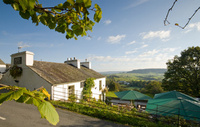Celebrate the blossom and enjoy a damson good day out
 One of England’s most deep-rooted, environmental traditions and days will this year be celebrated on April 19, at Low Farm, in the Lyth Valley, Cumbria as families gather to welcome the blossom.
One of England’s most deep-rooted, environmental traditions and days will this year be celebrated on April 19, at Low Farm, in the Lyth Valley, Cumbria as families gather to welcome the blossom.Damson Day celebrates the arrival of the glorious, white blossom on the damson trees in the beautiful Lyth and Winster Valleys and helps promotes the wonderful regional produce based upon the treasure that is the fruit of the Westmorland damson tree.
As the Lyth Valley is at its most stunning, the Westmorland Damson Association will be making their 11th event as successful as the previous ten. This is particularly important this year, as 2008 marks the 70th anniversary of the formation of the first Damson Growers Association.
The Damson Day event will comprise stalls hosted by regional producers using the damson to its best effect. Scrumptious damson breads, jams, chutneys, jellies, syrups, pies and chocolates will compete for attention with hard-to-resist damson ice cream, wine and delicious damson gin.
Other craft-based exhibitors will take part and there is a full programme of entertainment for all the family, throughout the day, including Highland dancing, archery, long and short orchard walks, all the fun of the fair, music and hound trails.
There will also be cookery demonstrations given by chef Nick Martin, a cheese demonstration by Andrew Holt and a black pudding demonstration.
Parking is available at Low Farm, but transport is also being laid on from Bowness-on-Windermere, Grange-over-Sands and Kendal, via Millennium Travel buses. Pick-up times will be 09.45 from Bowness-on-Windermere TIC, 10.45 from Grange-over-Sands TIC and 11.45 from Abbot Hall, in Kendal. Returns will be at 12.45, 14.30 and 15.30 respectively, all from Low Farm.
Excellent regional produce truly allows the visitor to eat the landscape, as well as helping support the aims of the Westmorland Damson Association. This Association aims to ensure the damson tree on England’s ecological map and that its fruit continues to play a major part in everyday life in the South Lakes area of Cumbria.
Those who fall in love with the damson, after one sip of its warming gin, or beer, can learn how to incorporate this fruit into their everyday life by purchasing a recipe book of 100 different culinary options. With Westmorland damsons on sale at 44 different farms, there’s every opportunity to use the damson within a variety of dishes.
Visitors can also learn how to grow and nurture their own damson tree – an important objective of the Association.
Damsons have been grown in the Westmorland area since the 1700s, if not earlier. Damsons may have been introduced by soldiers fighting in the Crusades, but evidence of damsons has also been found around Roman camps. Dye from damson skins was also used in Roman times.
1938 saw 250 tons of Westmorland damsons being sold to Lancashire jam and textile factories, in the days when Damson Saturday was a huge event in Kendal’s cultural calendar. The Second World War brought sugar and manpower shortages that killed the damson trade. Seventy years on, Damson Day should help revive love of the damson and put it firmly back on Britain’s culinary map.

